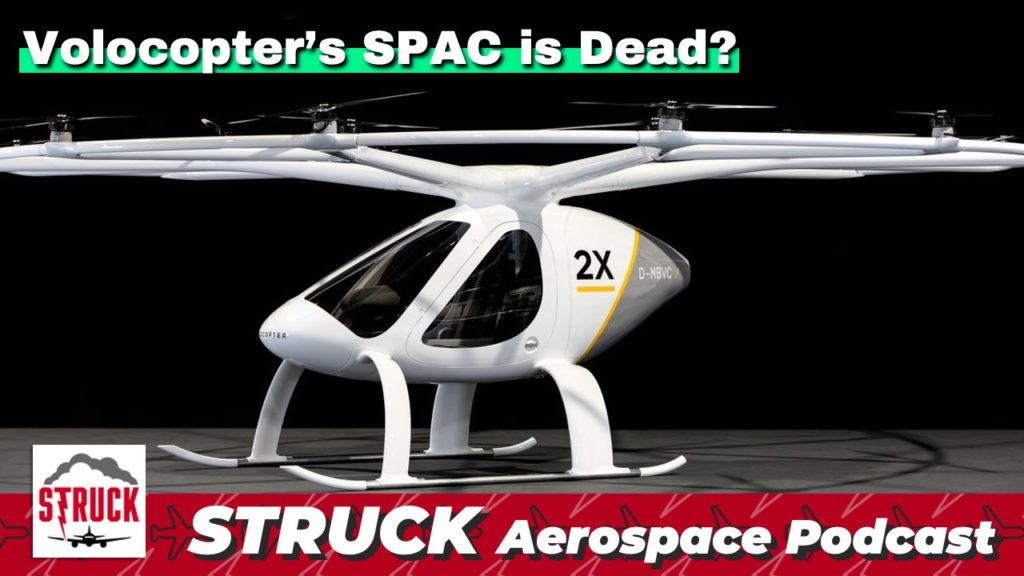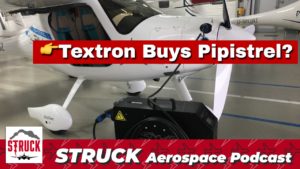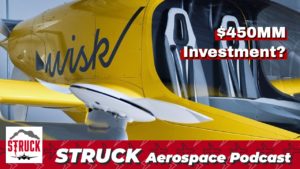This week we talked through a few EVTOL designs, including a very outside-the-box aircraft from Zeva, which looks like a flying Oreo cookie. Volocopter has cancelled its IPO via SPAC merger, and questions are still floating about their early crowd-funding investors. Plus, the FAA has found common ground on the 5G interference issue with major telecom companies – is this issue resolved?
Learn more about Weather Guard StrikeTape segmented lightning diverters and aircraft lightning protection consulting services. Follow the show on YouTube, Twitter, Linkedin and visit us on the web. Have a question we can answer on the show? Email us!
Transcript: EP81 – Volocopter Spac Cancelled + Zeva EVTOL Design
this episode is brought to you by weather guard lightning tech at weather guard we support design engineers and make lightning protection easy you’re listening to the struck podcast i’m dan blewett i’m Allen hall and here on struck we talk about everything aviation aerospace engineering and lightning protection all right welcome back to the struck aerospace engineering podcast i’m your co-host dan blewett great show today we’re going to first talk about a stowaway who survived a flight from guatemala to miami in the plains landing gear which is crazy uh so we’ll chat a little bit about that and just how a that’s even possible i get that’s part of the fifth element you know he goes through interstellar travel but here in real life that seems pretty implausible we’ll talk about the fcc the 5g rules and how that dispute is starting to get solved to an extent uh we’ll talk about textron their new beechcraft denali tea prop is uh out there flying for the first time and that’s actually an interesting little story and then our evtl segment we’ve got a bunch of different designs to talk through and big news from volocopter so look forward to that um alan’s going to pick apart a couple new designs and they keep coming which is pretty fascinating um so alan let’s start here with this stowaway uh you know this guatemalan man was taken to the hospital by immigration after emerging from the plane but tell us a little bit about the uh landing gear like how how is this possible i mean what’s the air situation like i mean you know planes you know pretty much in and out so how does this how does this work so the landing gear bays are not pressurized which means that you’re breathing atmospheric oxygen and they’re not heated either the only heat you would get is from just the heat of the brakes as the wheel is stowed and that won’t typically last all that long so if you’re up in that little hollow area where the wheel gets stored uh you’re i guess on that particular plane they i think they have covers over the wheels but 737 wouldn’t but but you’re still you’re still breathing 35 000 foot oxygen levels which should kill you it should give you hypoxia in about 15 20 minutes you would think and then the temperatures are going to be i know they went from a warm place to a warm place but you’re still at altitude so the temperatures up there are going to be well below zero fahrenheit and whatever that is in celsius it’s going to be really really cold so you should have a combination of frostbite slash hypoxia unless you could squirrel your way into an area where you can breathe some oxygen or you had oxygen on you but even still i think your chances of survival are almost zero you would think yeah so the faa actually has some data on this says since 1947 129 people have attempted to stow away in wheel wells or other areas uh and 100 have died so you know baker’s dozen people 10 of those 13 are gonna die if they try this that’s not a good rate yeah that’s scary no it’s just way too dangerous of a thing to pull off and i i kind of wonder if they were really in the wheel well or were they hidden away somewhere else and then tried to pop out of the wheel while trying to get away because the the environment there for breathing i mean you’re higher than mount everest for goodness sakes right so you have to have oxygen or your brain dies and need to have warmth or your body freezes and you don’t have either one of those things so it’s if this really did happen the way that’s presented i’d be surprised yeah and of course there’s a story from april 2014 a 16 year old boy uh survived five hours in the wheel well of a jetliner as it flew from california to hawaii that’s terrifying and crazy five hours going over the ocean not that going over the ocean really makes any difference um but you know it’s still it’s harrowing harrowing yeah and i don’t know what makes people think that this is a good idea like why why would you do it from california to hawaii like what’s the what’s the purpose of that well he was running away from home apparently oh buy a ticket it’s a lot easier yeah it isn’t i mean when you land i guess the obvious thing is that someone’s gonna notice all the crew on the ground are gonna immediately pick up that there’s a random person running around on the tarmac and say hey you especially in today’s tsa secure airport world you can’t think you’re just going to walk away from that i guess they don’t so it’s but still this is not advised and sometimes i think when they highlight uh things of this sort in the news it causes well it’s been proven statistically it causes more of it yeah yeah there’s gonna be more copycats of it because someone did it successfully which means we’re gonna probably have like you’re saying probably 10 people that won’t make it successfully and that’s not good yeah it’s kind of like going over niagara falls in a barrel it can it can be survived but highly inadvisable you will almost certainly not survive even though a couple people have survived it so yeah stay stay out of the wheel wells so moving on uh we talked a little bit about the fcc and 5g uh signals and the faa and how the faa is worried about uh 5g and the increased power of these uh and and i guess it’s more the spectrum and the band allen is that right or just the power itself and and the power too so there’s been some movement on that and at t and verizon uh in a letter addressed to the fcc said they’re going to lower power signals from their towers uh nationwide and then also additionally lower the power limits of the especially the c-band wireless spectrum when they’re near regional airports or helipads so alan does this uh strike you as a as a good solution of course there is no definitive evidence that this has any effect uh they’re just worried about it right well i i do feel the faa has some input on likely problems that are going to occur the faa is really unlikely to start squawking about frequency problems if they don’t exist they have have some experience with them in the past so somebody in their technical chain at the faa has seen this happen more likely so the i think that the fix is relatively simple obviously you can just when you’re around the airports just point the point the antennas away from the airport a little bit so you don’t radiate an airplane which would make total sense and lower the power down a little bit i don’t know lowering down the power nationwide makes a lot of sense unless they had extra power that they didn’t really need anyway so they’re willing to negotiate down to something they were comfortable with in the first place but the the real key is around the airport so that’s where you’re going to get the most exposure and that’s where in this particular case the radio altimeters are used primarily on takeoff and mostly landing but uh yeah the critical phases of flight as the faa calls it takeoff and landing so if you’re just careful around airports that makes a a lot of sense and there’s a lot of licensing and local issues that will have to be figured out as they go forward but at least the faa has a proposed solution on the table which is great because that needed to happen so i mean is this this strikes me kind of like the pregnancy thing where you know there’s uh so many you know foods off limits for pregnant women and of course they can’t test pregnant women like hey would you mind eating a bunch of soft cheeses during your pregnancy just so we can you know have definitive proof of what happens like obviously they would never do that so is this sort of a similar thing where they’re just looking at possible things that could have an issue and just trying to be extra cautious about it until they you know get more data yeah i think that’s possible you remember that the faa controls a lot of the frequency spectrum and defines and the their the faa and their sort of subsequent organizations define a lot of the frequency spectrum in terms of how equipment should perform how how equipment should react how sensitive equipment should be so they they have a really good knowledge of how the spectrum is used particularly in their frequency bands and what equipment operates inside of there and also they they do tend to keep a relatively good pulse on aircraft that have had problems with uh you know emissions susceptibilities those things are really important particularly on takeoff and landing you don’t want any airplane to misreact to some crazy spurious signals so they they do uh monitor all those things and i i having worked in this industry way too long at this point there there’s just like this sort of common knowledge like there’s older equipment is pretty susceptible to things sort of out of band so the equipment may work in a specific frequency narrow frequency band but it also receives stuff that it probably shouldn’t and because it’s just cheaper to manufacture that’s what it comes down to and in that making it cheaper to manufacture and there was no susceptibilities there or no emissions coming out from some random antenna on the ground it didn’t matter but now that we’re using more and more spectrum it really starts to matter so the the older equipment’s going to be more susceptible than your equipment as we get uh evolved we’ll we’ll put frequency blockers in that’ll eliminate that stuff so it’s on looking at the frequency which it really needs that’s easy to do with software or hardware it can be done either way but i think it’s really just an old technology versus new technology old technology airplanes versus new technology um all the 5g stuff that’s going to happen well moving on uh textron aviation has their new beechcraft denali which is a single engine turboprop that’s going to be powered by the ge catalyst engine um which is a departure from the longtime pt6a series from pratt and whitney uh they’ve made their maiden flight recently they seem really excited about it ellen what’s the big deal here about this uh about this textron beechcraft denali i think the it’s just the the engine oh and it’s something that uh textron beach has never really done before in terms of a single engine turboprop i mean they played around with it the concept for a long time because they’ve been making king airs forever and they’ve been making bonanzas forever so to make a turbo prop version of that it would seem logical what what happened is that pilatus made this a reality years ago with the pc-12 single-engine turboprop uh very popular up in canada in the united states hauls a lot of cargo it’s got a big cargo door on the back of it it seats a lot of people comfortably it’s very efficient on fuel so it has a really nice niche of a marketplace for the pilatus product and the beach never really wanted to dive into that too much because they’d be second to the marketplace and second by a long time right so pilatus has essentially established itself as the single engine turboprop bigger airplane uh product and now textron is trying to walk into that marketplace with an existing product it gets really hard if you’re sitting in the marketing room going well how are we going to sell this new airplane it looks like a pilatus and the answer is well we got this new ge engine that makes it cheaper to operate that’s that’s the answer
will that be enough of a differentiator don’t know right i think no one knows because pilatus has that marketplace sort of hemmed up and so even if pilatus lost st pilatus lost 10 20 of the marketplace they still own 80 of it and they still got a lot of airplanes out in service so it’s going to take a long time for textron to penetrate that market even with a new engine because it doesn’t seem like airplanes really sell so much on the engine as much as everything else all right see avionics package it’s the the cost of operation per mile sort of thing or per hour those are to be more important things but you know beach and cessna have lived off of airplanes that are 50-ish years old for a long time because they have established the the market space they established a category of airplanes and because they were first and they developed the best product over time really no one wants to enter those marketplaces but this sort’s a little weird that textron’s trying to do something which it knew it wasn’t good to do in the past we’ll see maybe maybe the ge engine is the is a total game changer maybe it is uh because right now pratt whitney has owned that marketplace forever the pt6 and all the variants of which i’ve lost track coming in and there are have been a really high quality product forever really reliable easy to maintain everybody knows how to fix it all that stuff so the ge aspect of this is really going to be the the market differentiation and dan do you do you think that it’d be like let me give a similar situation in the car if you’re going to go out buy a new corvette and it just had a slightly better engine is that going to make you go out and buy it no probably not yeah it’s going to be a pretty pretty big like step change to to warrant that yeah and of course the comments of this article from av web are people you know are people saying that exact thing it’s like well this looks like a green pilatus pc12 it’s like yeah so then the question is yes is there a big price difference is there a big package difference is the engine make you know a huge difference to the like you said the cost per hour um something operationally whatever uh yeah those are i guess the big questions because you’re right if you’re just churning out a identical identically priced ipad but your company’s not called apple why is someone going to buy that right right you’re going to get that 10 20 run the marketplace but you’re never going to penetrate to 50 at least in the next 10 years you won’t and that’s why that’s what makes this thing unique and i i wonder if they have a particular marketplace already to find our customer to find that is a cargo hauler like a ups or something like that that would that would make a lot of sense so moving on to our evtol segment today we’ve got a couple new designs to talk through one of them is from ziva and this is one of the for for sure more bizarre um designs out there and this one essentially looks like a eight foot tall disc where the human lays inside of it and it will go vertically up so if you’re an oreo cookie and you laid stood it up end on end it would then hover or you know lift up and then it would start to tilt and then that oreo cookie would fly off with you on the back of it so that’s probably the best way to characterize this um alan i mean we’ve seen a lot of bizarre evtl designs uh they’re claiming that you know this essentially acts like a wing so yes even though it’s shaped sort of like a disc um you know when flying horizontally it’s gonna have you know it’s gonna act like a wing but does this have any chance of meeting mass market appeal who is this thing gonna be for is this another thing that it’s fun to look at fun to read an article about and look at a design and then we all move on yeah those aircraft don’t tend to go very far because they just visually look unsafe not to say they are probably are not uh but they appear unsafe and you just seem like you’re at risk just the way you’re splayed out in this frisbee design with a bunch of propellers near you just seems the human instinct is to avoid danger even if it’s just an appearance sake and it looks like you’re exposed and if you were to have an accident in this aircraft which will happen that you’re you’re not necessarily going to walk away with that without any damage and i i think that’s real where it kicks in on some of these small aircraft is does it look safe is it sort of crash worthy does it have backup systems that prevent me from crashing into the ground if it doesn’t then there would be a very very limited supply of pilots that’ll want to try it or owners that don’t want to buy it and not to say the technology isn’t cool i think there’s maybe applications for it for packages and things of that sort and maybe that’s where they’re going this is to make something autonomous but at this point mass market appeal historically has not been there well one of the things they’re talking about which is you know from again if you think of standing a cookie up on its edge they’re saying you can park six or seven of them in a space and first responders could store them more easily and maybe there could be a military use where they’re just hanging out almost like a jet pack where run over throw the backpack on and take off you know run over and just get into this thing and go um which you know that’s a reasonable pro for this like it’s definitely more space efficient and um yeah but like you said i think there’s a lot of unanswered questions about um you know how stable it is when it lands because if it tips over as the rotors are still going as the propellers are still going that’s you know game over but um they have a full-scale prototype built and they’ve uh on youtube they’ve shown their their 1 8th scale model flying so they seem pretty serious about it and uh it’s definitely an interesting concept but it’s like like we we said it’s definitely one of the more bizarre just unfriendly to the eyes and again that doesn’t mean anything about the engineering of it it just it looks like people are going to be really skeptical and that’s going to be a hard hurdle to get over and if you if you think that the military is your application or ems which is involves a lot of governmental organizations that will oversee this thing that’s a hard path to go down i don’t know what seems conceptually like oh the army would buy this to put soldiers who are injured in combat you can toss them in this thing and it’ll fly back to wherever but you know the the military has people to review safety and protocol and structures and and those sort of things that’s a that’s a that’s a 10-year kind of development run if they even think it’s a worthy idea it’s just as a company if you put the if you start putting the company aspects the financial aspects on it it’s really hard to sustain a company without having significant revenue for that period of time and that’s that’s what kills a lot of these companies is that cash flow dries up because there’s just not a lot of immediate marketplace for the product and unfortunately that’s you know just the way business roles yeah and of course one of the really interesting diagrams that they have and uh this is an interesting article from new atlas we’ll link to but is this concept of a skydock for their uh their ziva so basically you could install this on your you know 44th floor you know apartment and this thing is going to go over and connect to it and then you’re going to walk right into your home and this is going to essentially they explain that you park it like a barnacle which i think is a good way of explaining it but you know and their idea of that hey you know rooftop space is going to be the premium in the future is probably correct right you know that’s probably correct but i don’t know how many people would have the stomach for this to park it on the edge of this of your skyscraper and then walk i mean it just it seems really really far in the future and like you said that doesn’t lend well to funding if this is that far away right because you’re talking about infrastructure on the building side to accommodate it and that doesn’t exist right now it’s very similar to the sort of the ev tall putting landing spots in even putting a simple landing spot in it’s going to cost you a hundred thousands of dollars uh in some cases so none of it’s easy it’s all about financing and where you can get enough backers to make it happen yeah not to mention this would be dangling over pedestrians so one thing tumbles down kills a person from i mean from that altitude anything is going to hit what terminal velocity if it’s 40 stories up maybe you know so you drop your cell phone someone dies below doesn’t bode well for the future of this right you know one docking error or anything that’s going to be tough and those are all issues with any flying car that you’ve raised in all these past episodes that the flying car concept is just really hard to do that in a big city you know like like new york where there’s just so many people on foot below that like nothing can go wrong without a pretty significant amount of casualties and that’s a that’s a huge hurdle right if if you pick the most complicated problem and try to solve that one first that’s the most difficult way to create a product i’ll give you the spacex comparison so spacex started out with simple problems not trying to land on a pad at the ocean right they were just like oh let’s just see if we can uh get a rocket into space and then they developed over time like let’s try to land on a landing pad in the middle of the ocean and then it didn’t work a couple of times and then they finally figured it out well it’s a similar thing right in that in that span of time where you’re destroying rockets it’s costing you millions and millions of dollars and the same thing exists in the airplane world right that but the problem is you got humans involved usually that the risks are so high and the costs are so amazingly uh complex and expensive that you just can’t really do it so you’ve got to have an answer that fits a marketplace today otherwise you’re just out of cash so moving on autoflight has gotten 100 million in new investment and of course they’re a chinese evt oil company and they’ve got a couple different models all of which look very impressive uh their v1500m made its made in flight back in october and it was a short one but it’s on youtube you can find it we’ll link to it um and it’s a it’s also a nice looking aircraft um you know it’s got the couple allen those are i’m gonna say is wrong those aren’t boom arms but what would you how would you characterize the v1500m it’s got two booms um stealthy looking looking cockpit yeah and it’s very similar to beta’s design but instead of having the propeller on the main fuselage part there’s the propellers on each of the and the back ends of each of the two booms so it’s just a different configuration but very similar in terms of its design except this is autonomous and betas is not yeah and of course autoflight has the v50 which they call their white shark which is a good also a good character is characterization for it’s uh also a handsome aircraft uh and their v400 the albatross which is more of an industrial evtol they explain um so they’ve got a lot of nice designs they don’t have that much uh flight time but they continue to get more investment now alan is this 100 million dollars how far you’ve talked about this at length how far is that going to take them about a third of the way through certification unless unless there’s some huge disruptive technology in play here uh it’ll get them about a third of the way it’s about a 300 to 500 million event to certify an airplane unless you’ve got uh well unless they’re doing any trying to do it in country it doesn’t sound like they are it sounds like they’re going to try to get eosa certification on it and iasa unlike the faa you have to pay for their help the faa comes free somehow some level uh so the there’s just a huge amount of technology you got to make aircraft you could get conforming aircraft i don’t know about the assa part of that faa you would uh so they’re they’re they need a fundraise you would think or get some government backing to to get to the end and the question is is there really a marketplace for it maybe and i think that’s the hardest part is trying to figure out is if you’re going to put in at 300 million dollars or is anybody going to get some other investment back out of it with a decent rate of return especially in conditions that exist today where inflation is five six eight percent it’s really hard to put it in an airplane company today and think you’re going to get that kind of return but you know stranger things have happened
yeah so let’s shift to our final uh topic for today which is volocopter and they have a really interesting story unfolding with their now uh scrapped spac plans so they’re no longer going to go public via spec which they had announced back earlier in the year and they have this interesting problem now with the 750 or so small crowdfunding investors who’d invested in the company and really got it going back in 2013. um alan take us through this problem a little bit what’s going on with volocopter why did they scrap their spac plans and what’s the issue here with the the crowd funding investors so the the way that the contracts were set up with the crowdfunding investors was they were going to get a one percent return on investment and there was a time in which uh volocopter could basically end the contract with them and just pay them off and they could go they would go away with their one percent that was sort of the basic foundation of it which is not a bad way to crowdfund at least you get your money back now you’re going to pay for the loss of inflate the inflationary pressure and the loss of your the devaluing of your money over time uh the one percent is not going to cover that clearly so you’re going to come back with less money than you pour it in and of course a key component of that was that each crowdfunding investor would get a potential profit sharing of 0.0036 percent so there was something there um when the company started making money and of course that volcopter has not made a dime yet as none of these evt oil companies have right so that was the other potential piece of the pie for those early crowdfunding investors so the the volacop is at a really weird place at the moment where they can remove the initial investors relatively inexpensively because they like profit sharing or own a piece of the company so you can just basically pay them off and reform a company under a spec and a spec is a basically a simplified way to get to a publicly traded company so you cre there’s a there’s an entity hanging out in space which has applied for all the the funding rules and it has enough cash to acquire a company because you never know which spax is going to require which company is sort of like like going to las vegas and putting putting all in black and then uh the spec requires a company pours in a bunch of money they reform in this new organization and then they have all this funding to go off and do what they need to go do in terms of design and certification but i think the the marketplace for spac has gone down and the amount of investment in spax have gone down right joby had some issues with their spac in terms of what the value initial evaluation of it and what they eventually raised same thing happened with archer i believe so if you did go that’s back route and you’re looking for 500 million dollars you may only end up with 200 300 million which is still a crazy amount of money but maybe not enough to actually get to the finish line so now your helicopter’s caught in this do you think dan they’re just kind of caught in this weird space of all these initial investors are going to be upset if they close out the investment but you can’t really get the cash needed to spec then what do you do yeah it’s not clear and they’ve said that this is basically going to send a really bad signal to crowd funding uh in germany in general because if eight years later you just get your money back with one percent per year um and not really any of the bigger gains that you’re hoping for or entitled to or however you’d want to phrase it it’s just uh it kind of leaves the people that really help build volocopter from you know a seven million dollar company in 2013 to a valuation of of a billion um whether or not you agree with that valuation is up to you but you know the company has expanded quite a bit in its value uh since those crowdfunders helped get it off the ground you know there’s a good evtl pun for you um so yeah i i think that’s it’s complicated and like you said the stock market has really seemed to bottom out recently um it was very hot a year ago and now it’s if you didn’t find a a suitor a company to merge with pretty quick you got pretty stale pretty fast and um and yeah so it’s i wouldn’t say this is surprising giving the the climate of of spax in the last six months so yeah but yeah it’s unclear what what this says for volocopter going forward because they’ve been one of the ones who’ve been in the press quite a bit they’ve been making a lot of moves showing their aircraft in flight which is great they’ve done a lot of good things that other companies have not but i don’t know where where are they headed now alan i i think volocopters has a really good chance of having a certified aircraft being used in multiple spots and they’re talking about paris for the olympics they’re talking about uh places over in asia uses over there so i think they have a marketplace it’s just question they’re going to produce aircraft in a real production standard you know they’re pumping out 500 200 of these things a year selling them out of profit are they doing the rideshare bit which it doesn’t seem like they are uh how do how is this all going to work where they this valuation that they have currently can be realized because you know valuations are one thing profits are another uh and there’s not many teslas and spacex’s in this world especially in aerospace they don’t tend to have absurd valuations we’ve seen some of them more recently but that doesn’t tend to last long so there’s a there’s a unique window in which volcopter has to make magic happen right so they gotta and this is the hard part about aerospace it’s a long halt before you get to profitability and but volocopter has been doing it for a while but now they’ve got they got this increasing window between their subscribers spax ipos and getting profitability so i’m certain those board meetings are really interesting right now internally because it’s a critical point there’s not a lot of people on the planet have navigated that situation successfully uh i hope that volocopter does it because i think they have a cool product and i think it actually moves the product evital world along a little bit to a place that it needs to go to but unless they can really make these transactions happen relatively quickly bullet copter could be on shaky ground and that’s that’s the scary part right you’d hate to lose them now yeah they’ve definitely made moves and they definitely have um it seems like as much vitality as any of these other evt oil companies so yeah it’ll be is it’ll be interesting to see what plays out at the next you know six months because there’s a lot of companies that have had their hat in the ring that don’t seem to be doing a lot or they’re just working hard behind the scenes maybe they’re just not ready to announce everything but you know joby and volcopter continually in the news cycle and starting to demonstrate flight more and more and more and talk about certification so they seem like the front runners so you’d like to see them continue with that momentum and get this because ultimately this the the industry needs someone to actually start flying people or products or cargo whatever around to to really start to see that the fog clear so hopefully hopefully this isn’t too much of a of a bad sign for for full copter well with the pandemic well i don’t know for pandemic endemic who knows anymore but i feel like there’s just a little short window here of opportunity before the world wakes up and says hey i can invest in other things i’m coming out of my home starting to work a little bit that those investment opportunities and these aircraft companies are going to get much more competitive because of other opportunities to invest in things that are maybe more profitable so the investment opportunity may be sort of pandemic driven on some level can you get a product out the door in the next 12 to 24 months i don’t think that really anybody has a chance at it besides maybe like an e-hang i’m not even sure what that means but or a volocopter those are kind of the two can you get it out something certified out flying in the marketplace or even on an experimental stage i think volocopter is it and there needs to be something in the next 12 to 20 24 months or it could really damage the image of the industry well that’s going to do it for this week’s episode of struck thanks so much for listening be sure to leave us a review we greatly appreciate it and subscribe to the show on spotify itunes stitcher youtube wherever you listen or watch thanks again and we will see you here next week on the struck aerospace engineering podcast strike tape weatherguard lightning tech’s proprietary lightning protection for radomes provides unmatched durability for years to come if you need help with your radon lightning protection reach out to us at weatherguardarrow.com that’s weatherguard aero.com












